ตำรามาตรฐานยาสมุนไพรไทย
Thai Herbal Pharmacopoeia
สำนักยาและวัตถุเสพติด กรมวิทยาศาสตร์การแพทย์ กระทรวงสาธารณสุข
Bureau of Drug and Narcotic, Department of Medical Sciences, Ministry of Public Health(Tinospora crispa (L.) Hook.f. & Thomson)
(Nelumbo nucifera Gaertn.)
(Centella asiatica (L.) Urb.)
(Centella Dry Extract)
(Centella Cream)
(Mesua ferrea L.)
(Piper sarmentosum Roxb.)
(Piper sarmentosum Roxb.)
(Pterocarpus santalinus L. f.)
(Santalum album L.)
(Senna tora (L.) Roxb.)
(Senna alata (L.) Roxb.)
(Senna Alata Tea)
(Piper retrofractum Vahl)
(Myristica fragrans Houtt)
(Andrographis paniculata (Burm. f.) Nees)
(Andrographis Capsules)
(Allium ascalonicum L.)
(Ocimum tenuiflorum L.)
(Curcuma longa L.)
(Turmeric Capsules)
(Turmeric Dry Extract)
(Turmeric Dry Extract Capsules)
(Arcangelisia flava (L.) Merr.)
(Curcuma sp.)
Harrisonia perforata (Blanco) Merr.
(Aristolochia pierrei Lecomte)
(Zingiber officinale Roscoe)
(Ginger Capsules)
(Ginger Tea)
(Cassia fistula L.)
(Nardostachys jatamansi (D. Don) DC.)
(Angelica sinensis (Oliv.) Diels)
Artemisia annua L.
(Ligusticum sinense Oliv. cv. Chuanxiong)
(Neopicrorhiza scrophulariiflora Pennell)
(Atractylodes lancea (Thunb.) DC.)
(Aucklandia lappa Decne)
(Terminalia chebula Retz.)
(Angelica dahurica (Hoffm.) Benth. & Hook. f. ex Franch. & Sav. var. dahurica)
(Kaempferia parviflora Wall. ex Baker)
(Hibiscus sabdariffa L.)
(Roselle Tea)
(Allium sativum L.)
(Zingiber zerumbet (L.) Sm.)
(Wurfbainia testacea (Ridl.) Škorničk.& A. D. Poulsen)
(Cannabis sativa L.)
(Myristica fragrans Houtt)
(Dracaena cochinchinensis (Lour.) S. C. Chen)
(Ficus racemosa L.)
(Hyptis suaveolens (L.) Poit.)
Clerodendrum indicum (L.) Kuntze
(Phyllanthus emblica L.)
(Citrus hystrix DC.)
(Citrus hystrix DC.)
(Areca catechu L.)
(Momordica charantia L.)
Moringa oleifera Lam.
(Aegle marmelos (L.) Corrêa)
(Solanum trilobatum L.)
(Morus alba L.)
Gynostemma pentaphyllum(Thunb.)
Makino
(Clinacanthus nutans (Burm. f.) Lindau)
(Cissus quadrangularis L.)
(Mimusops elengi L.)
(Zingiber montanum (J. König) Link. ex A. Dietr.)
(Piper betle L.)
(Capsicum annuum L.)
(Capsicum Oleoresin)
(Capsicum Gel)
(Piper nigrum L.)
(Piper nigrum L.)
(Eurycoma longifolia Jack)
(Thunbergia laurifolia Lindl.)
(Piper wallichii (Miq.) Hand.-Mazz.)
Senna garrettiana (Craib) H. S. Irwin & Barneby
(Terminalia bellirica (Gaertn.) Roxb.)
(Terminalia chebula Retz.)
(Caesalpinia bonduc (L.) H. Roxb.)
(Tarlmounia elliptica (DC.) H. Rob., S. C. Keeley, Skvaria & R. Chan)
(Hog Creeper Vine Dry Extract Capsiles)
(Hog Creeper Vine Dry Extract)
(Brachypterum scandens (Roxb.) Miq.)
(Lepidium sativum L.)
(Nigella sativa L.)
(Cuminum cyminum L.)
(Foeniculum vulgare Mill.)
(Plantago ovata Forssk.)
(Pimpinella anisum L.)
(Carum carvi L.)
(Anethum graveolens L.)
(Trachyspermum ammi (L.) Sprague)
Albizia procera (Roxb.) Benth.
(Acorus calamus L.)
(Tiliacora triandra (Colebr.) Diels)
Cyanthillium cinereum (L.) H. Rob.
(Orthosiphon aristatus (Blume) Miq.)
Murdannia loriformis (Hassk.) R. S. Rao & Kammathy
(Capparis micracantha DC.)
(Chrysopogon zizanioides (L.) Roberty)
(Cyperus rotundus L.)
(Cannabis sativa L.)
(Syzygium aromaticum (L.) Merr. & L. M. Perry)
(Boesenbergia rotunda (L.) Mansf.)
(Acanthus ebracteatus Vahl)
(Acanthus ilicifolius L.)
(Kaempferia galanga L.)
(Curcuma comosa Roxb.)
Betula alnoides Buch.-Ham. ex D. Don
Cannabis sativa L.
Carthamus tinctorius L
Mitragyna speciosa (Korth.) Havil
Mallotus repandus (Rottler) Müll. Arg
Azadirachta indica A. Juss. var. siamensis Valeton
Azadirachta indica A. Juss. var. siamensis Valeton
Punica granatum L.
Rhinacanthus nasutus (L.) Kurz
Baliospermum solanifolium (Burm.) Suresh
Curcuma aeruginosa Roxb
Boesenbergia kingii Mood & L. M. Prince
Senegalia rugata (Lam.) Britton & Rose
Acacia concinna (Willd.) DC.
Senegalia rugata (Lam.) Britton & Rose
Acacia concinna (Willd.) DC.
Senna alexandriana Mill. var. alexandriana
Cassia acutifolia Delile, Cassia angustifolia Vahl
Butea superba Roxb. ex Willd.
[Plaso superba (Roxb. ex Willd.) Kuntze, Rudolphia superba (Roxb. ex Willd.) Poir.
Pueraria candollei Graham
ex Benth. var. mirifica (Airy Shaw & Suvat.) Niyomdham
Streblus asper Lour.
Suregada multiflora (A. Juss.) Baill. (Gelonium
multiflorum A. Juss.
Piper Sarmentosum Root is the dried root and stolon of Piper sarmentosum Roxb. (Family Piperaceae), Herbarium Specimen Number: BKF 184896, Crude Drug Number: DMSc 1189.
Constituents Piper Sarmentosum Root contains phenylpropanoids (e.g., asaricin) and amide alkaloids (e.g., pellitorine, sarmentamides, sarmentine). It also contains flavonoids, lignans, β-sitosterol, volatile oil, etc.
Description of the plant (Figs. 1a, 1b) See under Piper Sarmentosum Leaf.
Description Odour, characteristic; taste, pungent.
Macroscopical (Fig. 1a) Cylindrical, 1 to 3 mm in diameter, various lengths, with stolons, blackish brown.
Microscopical (Figs. 2a, 2b, 2c) Transverse section of the root shows epidermis in primary growth, periderm in secondary growth, cortex, and vascular tissue. Epidermis: a layer of rectangular cells and unicellular root hairs. Periderm: a few layers of thin-walled rectangular cork cells. Cortex: thin-walled parenchyma cells, some containing starch grains, and/or microcrystals, thick-walled sclereids, oil cells, and layers of rectangular endodermis in primary growth. Vascular tissue: in primary growth, polyarch; secondary growth,
phloem and xylem. Pith: polygonal parenchyma, some containing starch grains and oil cells.
Transverse section of the stolon shows epidermis, cortex, vascular tissue, and pith. Epidermis: a layer of rectangular cells, uni-, bi- and tricellular trichomes. Cortex: thin-walled parenchyma cells, some containing starch grains, and/or microcrystals, thick-walled
sclereids, oil cells, pericyclic fibres, and group of collenchyma. Vascular tissue: phloem, xylem and vascular cambium. Pith: polygonal parenchyma, some containing starch grains, oil cells and pith cavity.
Piper Sarmentosum Root in powder possesses the diagnostic microscopical characters of the unground drug. Epidermis associated with a few layers of thin-walled cork cells and/or root hairs, elongated sclereids, and parenchyma containing larger and smaller starch grains and microcrystals are characteristic.
Packaging and storage Piper Sarmentosum Root shall be kept in well-closed containers, protected from light, and stored in a dry place.
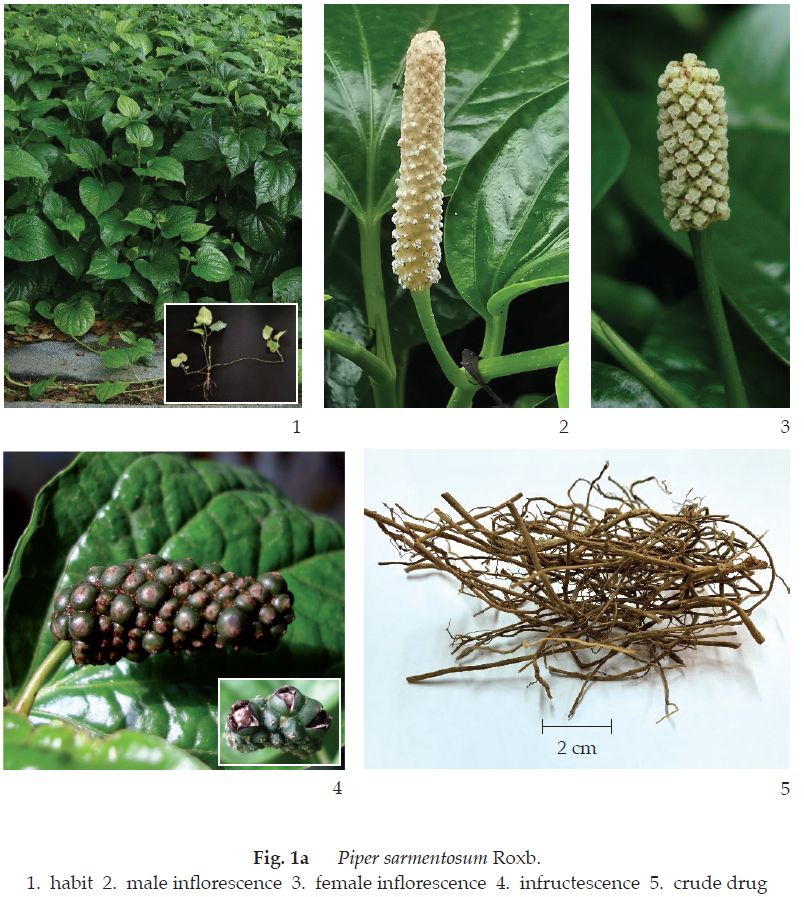
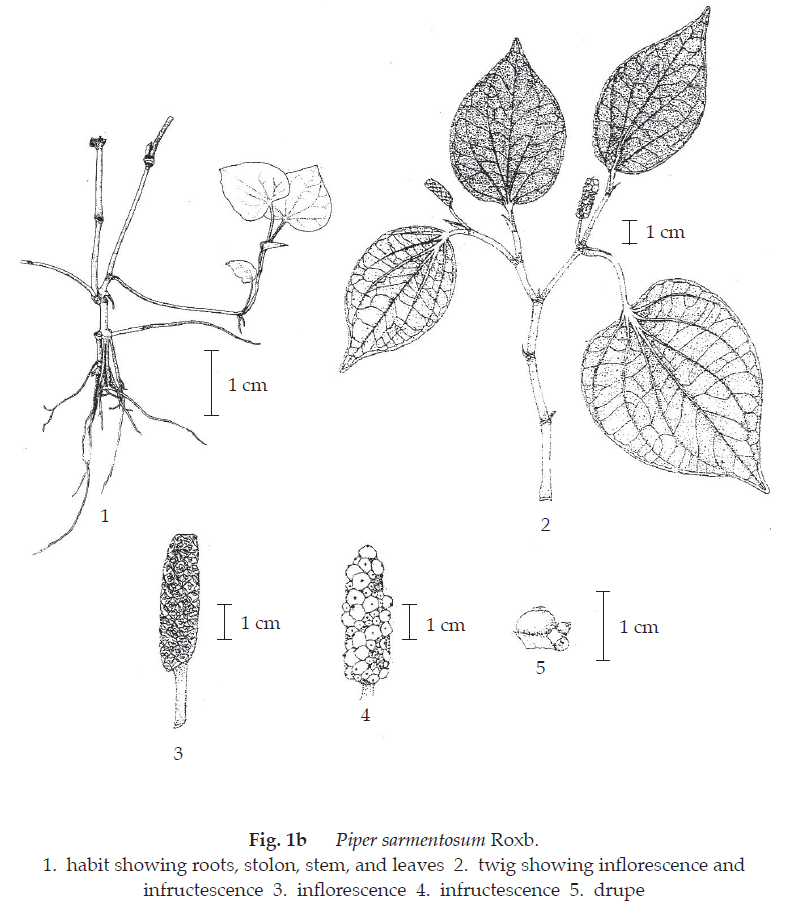
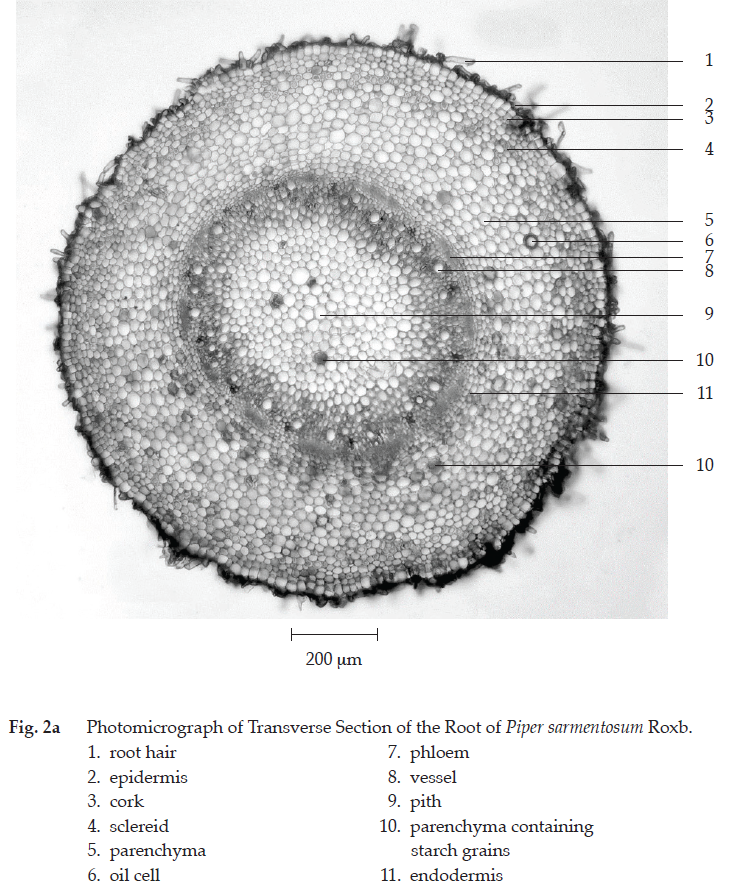
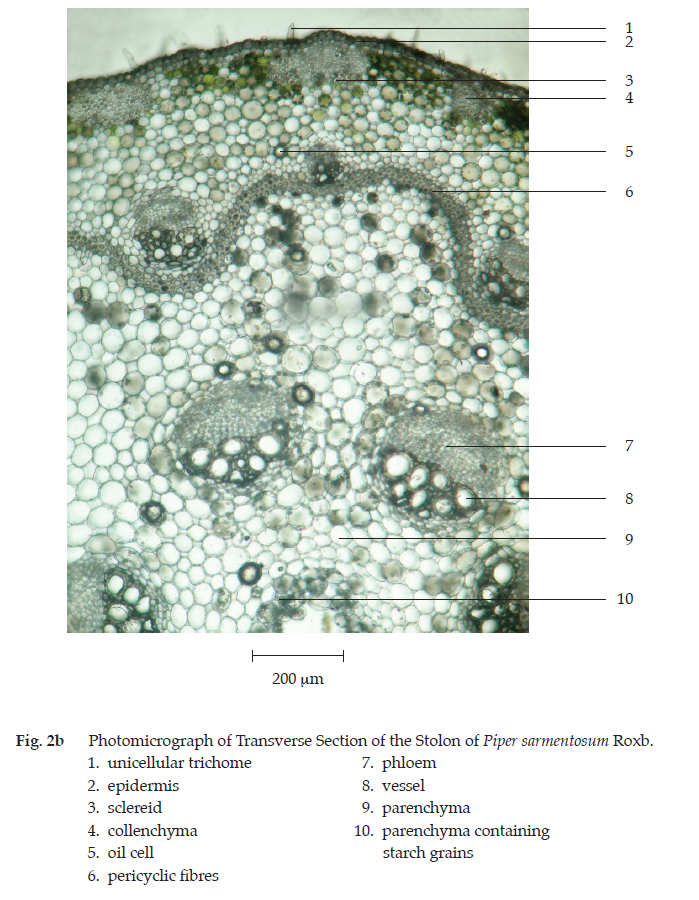
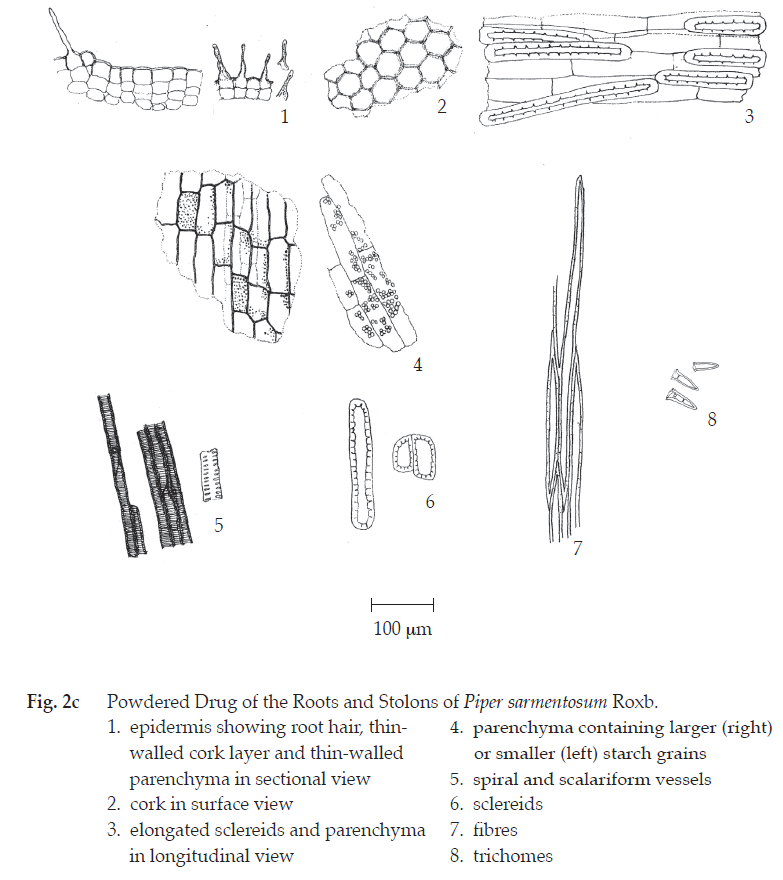
Identification
A. Macerate 1 g of the sample, in coarse powder, with 20 mL of ethanol, shake frequently during the first 6 hours, allow to stand for 18 hours and filter. To 2 mL of the filtrate, add a few drops of iron(III) chloride TS: a green colour is produced.
B. Carry out the test as described in the “Thin-Layer Chromatography” (Appendix 3.1), using silica gel F254 as the coating substance and a mixture of 90 volumes of ethyl acetate and 30 volumes of toluene as the mobile phase. Apply to the plate, as a band of 10 mm, 10 μL of the test solution prepared by macerating 500 mg of the sample, in coarse powder, with 25 mL of ethanol for 24 hours, filtering and evaporating the filtrate to dryness. Dissolve the residue in 0.5 mL of ethanol. After removal of the plate, allow it to dry in air and examine under ultraviolet light (254 nm), marking the quenching bands. Subsequently examine the plate under ultraviolet light (366 nm) through the cut-off filter; several fluorescent bands of different colours are observed. Spray the plate with anisaldehyde TS and heat at 105° for 10 minutes; several bands of different colours are observed (Table 1); see also Fig. 3.
Table 1 hRf Values of Components in Ethanolic Extract of the Roots and Stolons of Piper sarmentosum Roxb.
| Band | hRf Value | Detection | ||
| UV 254 | UV 366 | Anisaldehyde TS | ||
| 1 | 5-7 | quenching | - | greyish purple |
| 2 | 9-11 | quenching | intense blue | - |
| 3 | 14-16 | - | light red | - |
| 4 | 24-26 | weak quenching | light blue | - |
| 5 | 29-31 | - | light blue | greyish purple |
| 6 | 36-38 | quenching | light blue | pale yellowish grey |
| 7 | 41-44 | quenching | light blue | pale greyish purple |
| 8 | 54-56 | quenching | light green | purple |
| 9 | 59-61 | - | blue | - |
| 10 | 63-68 | - | blue | dark purple |
| 11 | 71-74 | quenching | light blue | purple |
| 12 | 76-79 | - | blue | pale purple |
| 13 | 79-83 | quenching | - | yellow |
| 14 | 87-90 | - | - | dark purple |
Loss on drying Not more than 10.0 per cent w/w after drying at 105° to constant weight (Appendix 4.15).
Foreign matter Not more than 2.0 per cent w/w (Appendix 7.2).
Acid-insoluble ash Not more than 4.0 per cent w/w (Appendix 7.6).
Total ash Not more than 14.0 per cent w/w (Appendix 7.7).
Ethanol-soluble extractive Not less than 3.0 per cent w/w (Appendix 7.12).
Water-soluble extractive Not less than 7.0 per cent w/w (Appendix 7.12).
